RoschetzkyIstockPhoto/iStock Editorial via Getty Images
Investment Thesis
Back on Nov. 30, 2021, with the share price at $72.59, I published an article, “MGE Energy: Historically High Multiple Likely To Continue To Underpin Share Price“. Since that time, the share price has increased by 6.94% to $75.86 on June 28, 2022, compared to a 16.32% decline in the S&P 500. While MGE Energy, Inc. (NASDAQ:MGEE) is never likely to be a multibagger, its transformation in the area of renewables and upgrading systems has seen a turnaround in earnings and EPS after several years of stagnation. EPS of $2.82 for FY 2017 was followed by EPS between $2.43 and $2.60 through end of 2020. But increased investment has seen EPS for FY 2021 of $2.93, an increase by 12.7% over the $2.60 for 2020. SA Analysts’ consensus EPS estimate for 2022 is for a further 5.5% increase to $3.09. The company is committed to its own and its customers’ decarbonization, as detailed in June press release, which is well worth reading for potential investors in the company’s stock. Of particular interest, MGE Energy is seeking regulatory approval to expand opportunities to manage EV charging on the grid.
MGEE has a current dividend yield a little under 2% and 46 years of uninterrupted dividend growth. A continuation of that performance far into the future appears highly likely. Based on the range of analysts’ EPS estimates for 2023, and assuming the P/E ratio remains at current level of 26.68, total returns of ~7% to 12% are indicated for buying now and holding to end of 2023. There is a downside risk of multiples shrinking to around 5-year low of 22.38 which would likely result in breakeven returns in the short term through end of 2023. This would not affect the continued payment of dividends, and ongoing earnings growth would likely result in positive returns for a longer term hold beyond 2023. MGEE remains a hold for existing shareholders and a potential buy for prospective investors in the stock, particularly on any dip in share price.
Looking for share market mispricing of stocks
What I’m primarily looking for here are instances of share market mispricing of stocks due to distortions to many of the usual statistics used for screening stocks for buy/hold/sell decisions. The usual metrics do not work when the “E” in P/E is distorted by the impact of COVID-19. And if the P/E ratio is suspect, so too, then, is the PEG ratio similarly affected. I believe the answer is to start with data at the end of 2019, early 2020, pre-COVID-19 and compare to projections out to the end of 2022 or later, when hopefully the impacts of COVID-19 will have largely dissipated. Summarized in Tables 1, 2, and 3 below are the results of compiling and analyzing the data on this basis.
Table 1 – Detailed Financial History And Projections
Data sources: Seeking Alpha Premium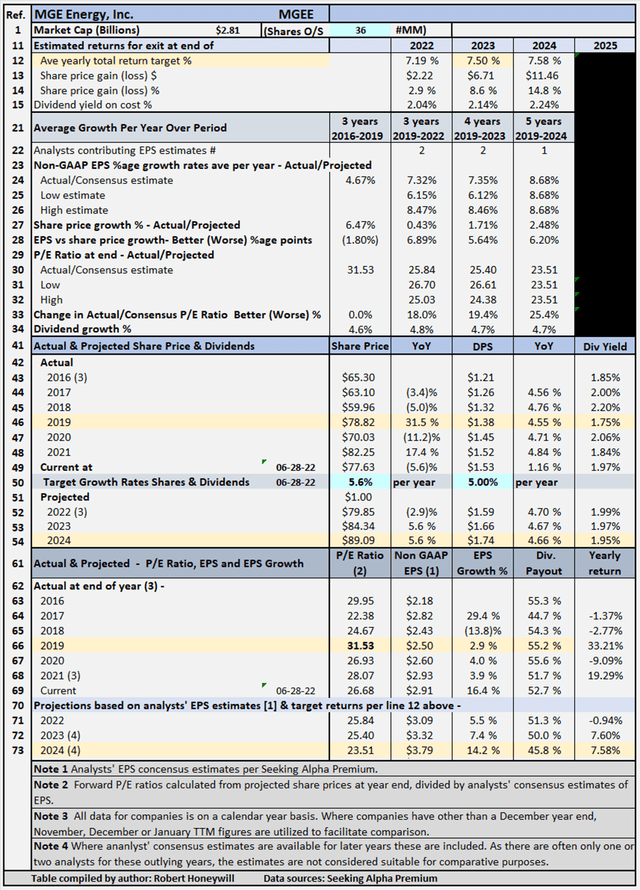
Table 1 documents historical data from 2016 to 2019, including share prices, P/E ratios, EPS and DPS, and EPS and DPS growth rates. The table also includes estimates out to 2024 for share prices, P/E ratios, EPS and DPS, and EPS and DPS growth rates (note – while estimates are shown for analysts’ EPS estimates out to 2023, 2024 and 2025 where available, estimates do tend to become less reliable, the further out the estimates go. These estimates are generally only considered sufficiently reliable if there are at least three analysts’ contributing estimates for the year in question). Table 1 allows modeling for target total rates of return. In the case shown above, the target set for total rate of return is 7.5% per year through the end of 2023 (see line 12), based on buying at the Jun. 28, 2022, closing share price level. As noted above, estimates become less reliable in the later years. In the case of MGE Energy, I have decided to input a target return based on 2023 year, which has EPS estimates from only two analysts, due to lack of additional analyst coverage. The table shows to achieve the 7.5% return, the required average yearly share price growth rate from Jun. 28, 2022, through Dec. 31, 2023, is 5.6% (line 50). Dividends, including estimated dividend increases, account for the balance of the target 7.5% total return. Table 2 below summarizes relevant data flowing from the assumption of a target 7.5% total return through the end of 2023.
Targeting A 7.5% Return
Table 2 – Targeting a 7.5% return
Data sources: Seeking Alpha Premium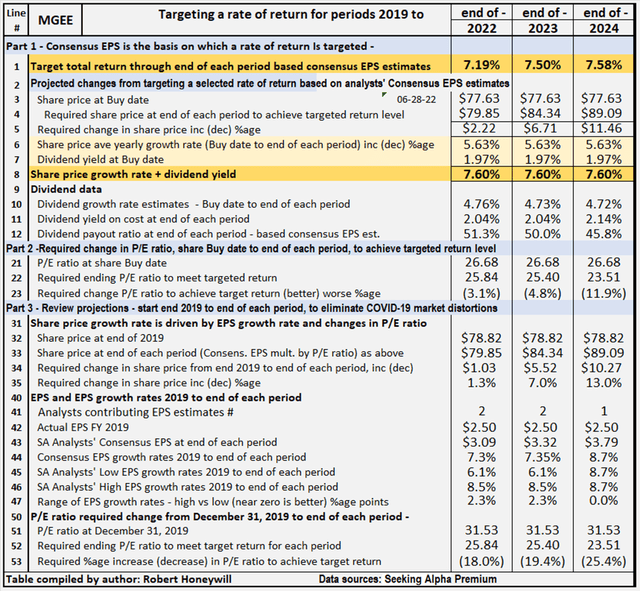
Table 2 provides comparative data for MGE Energy, assuming share price grows at rates sufficient to provide total rate of return of 7.5%, from buying at closing share price on Jun. 28, 2022, and holding through the end of 2023. All EPS estimates are based on analysts’ consensus estimates per SA Premium.
Comments On Table 2 Are As Follows
Part 1 – Consensus EPS (Case 1.1) (lines 1 to 12)
Part 1 shows the amounts the share price would need to increase to achieve a 7.5% rate of return through the end of 2023. The share price would need to increase by $6.71 from the present $77.63 to $84.34 at the end of 2023, for the 7.5% rate of return to be achieved.
Part 2 – Required change in P/E ratio to achieve target 7.5% return (lines 21 to 23)
Part 2 shows the amount the P/E ratio would need to increase or decrease by, from buy date to the end of 2023, to achieve the share price level at the end of 2023 necessary to achieve the targeted 7.5% return. For MGE Energy, the P/E ratio at buy date could decrease by (4.8)% through the end of 2023 and the 7.5% return would still be achieved. Being able to achieve a targeted return with a decrease in the P/E ratio would normally be regarded as a positive. However, due to the distortions in earnings and sentiment owing to the COVID-19 pandemic, it’s difficult to judge whether the change in P/E ratio is a positive or the result of a distorted starting point. To overcome this difficulty, in Part 3, I review the necessary change in P/E ratio from a different, pre-COVID-19 starting point.
Part 3 – Projected change in P/E ratios from 2019 to 2023 (lines 31 to 46)
In Part 3, I start with the share price at Dec. 31, 2019, before the impact of the COVID-19 pandemic on earnings and market sentiment. The end point is projected share price at the end of 2023, when it’s assumed the market and earnings are no longer materially impacted by the pandemic, and EPS growth has brought the P/E ratio back closer to historical levels. For MGE Energy, the share price needs to increase by $5.52 from $78.82 at Dec. 31, 2019, to $84.34 at the end of 2023, and as detailed in Part 1, at $84.34, the targeted 7.5% rate of return would be achieved. For MGE Energy, there are a number of givens in our assumptions. Using these givens, the change in the share price from Dec. 31, 2019, to the end of 2023, can be expressed as mathematical formulae as follows:
[A] Change in share price, due to the effect of EPS growth rate, equals share price at the beginning multiplied by (1 plus average yearly Consensus EPS growth rate) to the power of number of years invested.
= $78.82*(1+7.35%)^4 = $104.67 (that would be the result if the share price grew in line with EPS growth, and the P/E multiple remained constant)
[B] Change in share price due to change in P/E ratio equals share price adjusted for EPS growth rate multiplied by (1 plus/minus percentage change in P/E ratio).
= $104.67*(1- 19.4%) = $84.34 (price required at end of 2023 to provide 7.5% total return, buying at current share price).
The increase of $25.85 ($104.67 minus $78.82) due to the average yearly EPS growth rate is cumulative, and the share price will continue to increase the longer the shares are held, and the growth rate continues. The decrease of $20.33 due to a change in the P/E ratio ($104.67 minus $84.34) has a one-off effect. A continuing high or low P/E ratio has no impact on future share price growth, only a change in P/E ratio affects share price, not the level of P/E ratio.
Next, rather than targeting a specific rate of return, I look at historical P/E ratios to see the potential impact on returns of a reversion to these levels of P/E ratio. First of all, I should explain a little about the Dividend Growth Income+ Club approach to financial analysis of stocks.
Understanding The Dividend Growth Income+ Club Approach
Copyright: Robert Honeywill 2020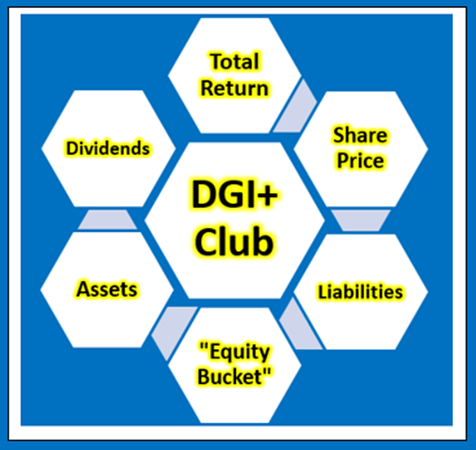
Total return, dividends, share price
The only way an investor can achieve a positive return on an investment in shares is through receipt of dividends and/or an increase in the share price above the buy price. It follows what really matters in share value assessment is the expected price at which a buyer will be able to exit shares and expected cash flow from dividends.
Changes in share price
Changes in share price are driven by increases or decreases in EPS and changes in P/E ratio. Changes in P/E ratio are driven by investor sentiment toward the stock. Investor sentiment can be influenced by many factors, not necessarily stock-specific.
“Equity bucket”
Earnings are tipped into the “Equity Bucket” for the benefit of shareholders. It’s prudent to check whether distributions out of and other reductions in the “Equity Bucket” balance are benefiting shareholders.
MGE Energy’s Projected Returns Based On Selected Historical P/E Ratios Through End Of 2023
Table 3 below provides additional scenarios projecting potential returns based on select historical P/E ratios and analysts’ consensus, low, and high EPS estimates per Seeking Alpha Premium through the end of 2023.
Table 3 – Summary of relevant projections MGE Energy
Data sources: Seeking Alpha Premium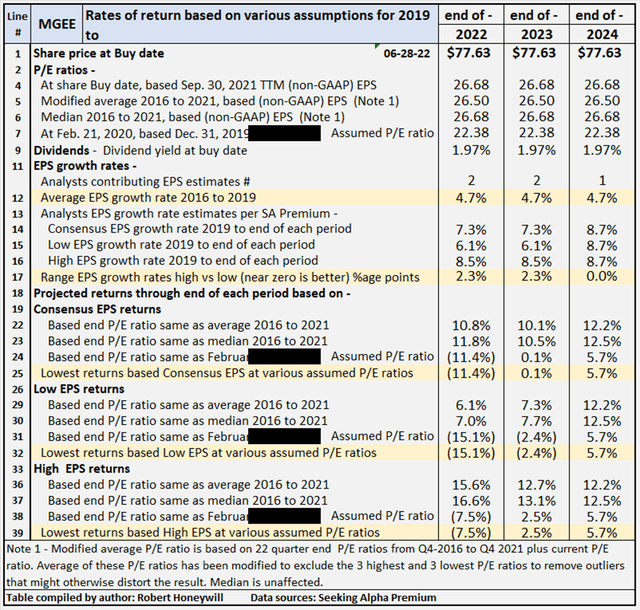
Table 3 provides comparative data for buying at closing share price on Jun. 28, 2022, and holding through the end of 2023. There’s a total of nine valuation scenarios for the year, comprised of three EPS estimates (SA Premium analysts’ consensus, low, and high) across three different P/E ratio estimates, based on historical data. MGE Energy’s P/E ratio is presently 26.68. For many companies, their current P/E ratios are distorted by the impact of COVID-19. For MGE Energy, the present P/E ratio is within the range of historical P/E ratios. Table 3 shows potential returns from an investment in shares of the company at a range of historical level P/E ratios. This analysis, from hereon, assumes an investor buying MGE Energy shares today would be prepared to hold through end of 2023, if necessary, to achieve their return objectives. Comments on contents of Table 3, for the period to 2023 column follow.
Consensus, low, and high EPS estimates
All EPS estimates are based on analysts’ consensus, low, and high estimates per SA Premium. This is designed to provide a range of valuation estimates ranging from low to most likely to high based on analysts’ assessments. I could generate my own estimates, but these would likely fall within the same range and would not add to the value of the exercise. This is particularly so in respect of well-established businesses such as MGE Energy. I believe the “low” estimates should be considered important. It’s prudent to manage risk by knowing the potential worst-case scenarios from whatever cause.
Alternative P/E ratios utilized in scenarios
- The actual P/E ratios at share buy date based on actual non-GAAP EPS for FYE 2021.
- A modified average P/E ratio based on 23 quarter-end P/E ratios from Q4 2016 to Q1 2022 plus current P/E ratio in Q2 2022. The average of these P/E ratios has been modified to exclude the three highest and three lowest P/E ratios to remove outliers that might otherwise distort the result.
- A median P/E ratio calculated using the same data set used for calculating the modified average P/E ratio. Of course, the median is the same whether or not the three highest and lowest P/E ratios are excluded. Coincidentally, the current P/E ratio is similar to the median P/E ratio, so we can see the effect of the P/E ratio continuing at present level.
- The actual P/E ratio at Feb. 21, 2020, share price, based on 2019 non-GAAP EPS. The logic here is the market peaked around Feb. 21, 2020, before any significant impact from COVID-19 became apparent. This makes the P/E ratios at Feb. 21, 2020, reflective of most recent data before the distortion of P/E ratios by the impact of the coronavirus pandemic. In the case of MGE Energy, the P/E ratio at Feb. 21, 2020, appears anomalous at 32.33. I have found it preferable to include an assumption of a P/E ratio of 22.38 which is at the low end of its historical P/E ratios. This might be considered a worst case scenario as far as P/E ratios are concerned.
Projected returns (lines 18 to 39)
Lines 25, 32 and 39 show if MGE Energy P/E multiple were to contract from present level of 25.89 to around its historical low of 22.38, and consensus EPS estimates were achieved, around breakeven returns could be expected through end of 2023. The analysts low EPS estimates coupled with the historical low 22.38 P/E ratio would produce a worst case indicative return of negative (2.7)%.On the other hand, if multiple contracted slightly from present level to the historical average of 26.50, returns of 7.3% to 12.7% are indicated, with consensus 10.1%. Slightly higher returns are indicated should the P/E multiple remain at current level, which is similar to the historical median.
Review Of Historical Performance For MGE Energy
MGE Energy: Historical shareholder returns
In Table 4 below, I provide details of actual rates of return for MGE Energy shareholders investing in the company over the last six years.
Table 4
Data sources: Seeking Alpha Premium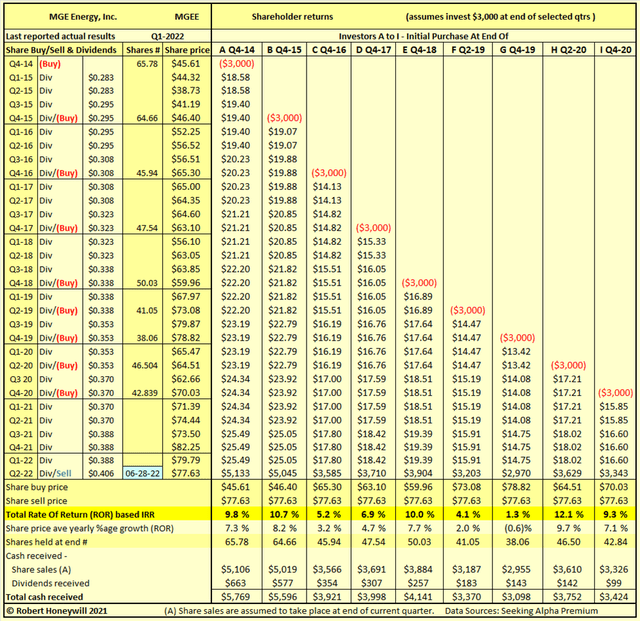
For many stocks where I create a table similar to Table 4 above, I find a wide range of returns indicating a degree of volatility and risk. Table 4 above shows high single-digit to double-digit returns for five of nine different investors, each investing $3,000 over the last five years and holding to the present. A further three investors achieved single-digit returns of 4.1%, 5.2% and 6.9%. The remaining investors return was 1.3%, less than the dividend yield, due to buying at a time of elevated share price at the end of 2019. These rates of return, ranging from positive 12.1% to 1.3%, are not just hypothetical results. They are very real results for anyone who purchased shares on the various dates and held through to Jun. 28, 2022. In the above examples, the assumed share sale price is the same for all investors, illustrating the impact on returns of the price at which an investor buys shares.
Checking MGE Energy’s “Equity Bucket”
Table 5.1 MGE Energy Balance Sheet – Summary Format
Data sources: Seeking Alpha Premium & SEC filings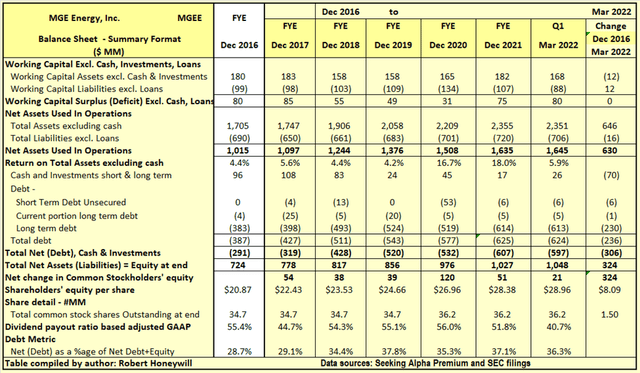
Table 5.1 shows MGE Energy has increased net assets used in operations by $630 million over the last 5.25 years. The increase was funded by $324 million in equity and $306 million in net debt. Net debt as a percentage of net debt plus equity increased from 28.7% to 36.3%, over the 5.25-year period. Outstanding shares increased by 1.5 million from 34.7 million to 36.2 million, over the period. The $324 million increase in shareholders’ equity over the last 5.25 years is analyzed in Table 5.2 below.
Table 5.2 MGE Energy Balance Sheet – Equity Section –
Seeking Alpha Premium & SEC filings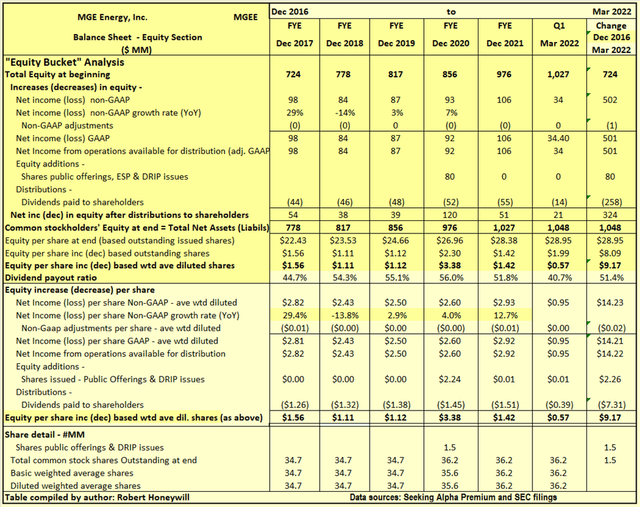
I often find companies report earnings that should flow into and increase shareholders’ equity. But often the increase in shareholders’ equity does not materialize. Also, there can be distributions out of equity that do not benefit shareholders. Hence, the term “leaky equity bucket.” I can assure readers there are no leaks in MGE Energy’s equity bucket. There are no stock compensation share issuances for staff, and there are no share repurchases. That is not to say there is necessarily anything wrong with stock compensation and buybacks, just that they provide an avenue for abuse at times. In the case of MGE Energy, the only distributions are in the form of dividends to shareholders.
Explanatory comments on Table 5.2 for the period from end FY-2016 to end Q1-2022.
- Reported net income (non-GAAP) over the 5.25-year period totals $502 million, equivalent to diluted net income per share of $14.23.
- Over the 5.25 years, most of the company’s net income growth occurred in 2017, following which there was a dip in net income in 2018. Net income appears to be showing a resumption of growth with EPS beats in Q1, Q2 and Q3 2021. Despite a miss in Q4 2021, full year EPS was up 12.7% on FY-2020. A small miss ($0.02) occurred in Q1 2022.
- MGE Energy reports purely on the basis of GAAP results, with none of the non-GAAP adjustments seen with other companies, which almost invariably increase headline reported profits.
- Other comprehensive income includes such things as foreign exchange translation adjustments in respect to buildings, plant, and other facilities located overseas and changes in valuation of assets in the pension fund – these are not passed through net income as they fluctuate without affecting operations and can easily reverse in a following period. Nevertheless, they do impact on the value of shareholders’ equity at any point in time. For MGE Energy, these items totaled to nil over the 5.25 years.
- There were no share issues to employees, and there were no share repurchases. There are bonuses for staff based on equity but these are not material and are settled in cash.
- For most companies, by the time we take the above-mentioned items into account, we find the headline reported non-GAAP net income has considerably reduced, providing less funds from operations available for distribution to shareholders. For MGE Energy we find the reported net income of $502 million for the 5.25-year period is all available for distribution to shareholders.
- Dividends of $258 million were adequately covered by the $502 million generated from operations, leaving $244 million increase in equity. This $244 million from operations, plus $80 million from shares issued to raise additional capital, resulted in the increase of $324 million in shareholders’ funds per Table 5.1 above.
Summary and Conclusions
MGE Energy stock is a “sleep well at night” investment. It can be seen from the analysis above, downside risk for returns is limited and upside is potentially quite good. The dividend for this dividend king is very well covered by earnings. There is no reason to think the 46 years of unbroken dividend growth will not continue into the foreseeable future. I am generally in agreement with SA Quant ratings, so I am intrigued by the C- rating for Dividend safety shown in Figure 1 below
Figure 1
I expect the Payout Ratio of 52.66% is what triggers the C- for Dividend Safety in the Quant rating. The 52.66% payout ratio is consistent with the data in Table 5.2, but Table 5.2 shows the dividend appears very safe. Despite the level of payout ratio, over the last five years, MGE Energy has paid out $247 million in dividends, invested an additional $630 million in net operating assets, and increased shareholders’ equity by $324 million, while maintaining net debt as a percentage of net debt plus equity around 34% to 38%. It would appear it is valuation and dividend yield that is resulting in the Quant rating being a Hold rather than a Buy. It is likely investors’ perception of dividend safety reinforced by dividend king status that is holding up share price (valuation) with a consequent lowering of dividend yield. I rate MGE Energy a definite hold for existing investors and a buy for investors seeking security of investment and dividends, and prepared to accept modest returns with potential for upside.


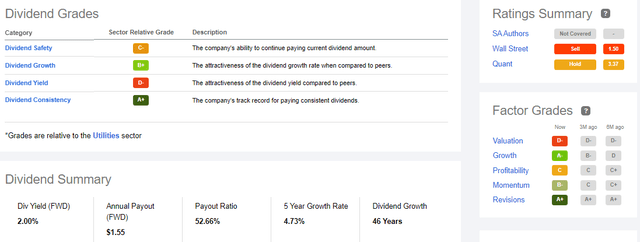
Be the first to comment